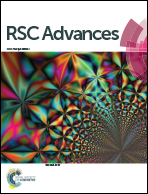Synthesis and photoluminescence properties of a novel Sr2CeO4:Dy3+ nanophosphor with enhanced brightness by Li+ co-doping
Abstract
A series of Dy3+ (0.5–9 mol%) and Li+ (0.5–3 mol%) co-doped strontium cerate (Sr2CeO4) nanopowders are synthesized by low temperature solution combustion synthesis. The effects of Li+ doping on the crystal structure, chemical composition, surface morphology and photoluminescence properties are investigated. The X-ray diffraction results confirm that all the samples calcined at 900 °C show the pure orthorhombic (Pbam) phase. Scanning electron microscopy analysis reveals that the particles adopt irregular morphology and the porous nature of the product. Room temperature photoluminescence results indicate that the phosphor can be effectively excited by near UV radiation (290 to 390 nm) which results in the blue (484 nm) and yellow (575 nm) emission. Furthermore, PL emission intensity and wavelength are highly dependent on the concentration of Li+ doping. The emission intensity is enhanced by ∼3 fold with Li+ doping. White light is achieved by merely varying dopant concentration. The colour purity of the phosphor is confirmed by CIE co-ordinates (x = 0.298, y = 0.360). The study demonstrates a simple and efficient method for the synthesis of novel nanophosphors with enhanced white emission.


 Please wait while we load your content...
Please wait while we load your content...